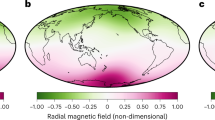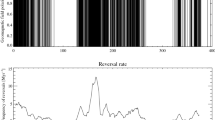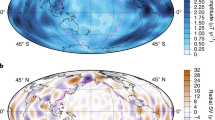Abstract
A series of computer simulations of the Earth's dynamo illustrates how the thermal structure of the lowermost mantle might affect convection and magnetic-field generation in the fluid core. Eight different patterns of heat flux from the core to the mantle are imposed over the core–mantle boundary. Spontaneous magnetic dipole reversals and excursions occur in seven of these cases, although sometimes the field only reverses in the outer part of the core, and then quickly reverses back. The results suggest correlations among the frequency of reversals, the duration over which the reversals occur, the magnetic-field intensity and the secular variation. The case with uniform heat flux at the core–mantle boundary appears most ‘Earth-like’. This result suggests that variations in heat flux at the core–mantle boundary of the Earth are smaller than previously thought, possibly because seismic velocity anomalies in the lowermost mantle might have more of a compositional rather than thermal origin, or because of enhanced heat flux in the mantle's zones of ultra-low seismic velocity.
This is a preview of subscription content, access via your institution
Access options
Subscribe to this journal
Receive 51 print issues and online access
$199.00 per year
only $3.90 per issue
Buy this article
- Purchase on Springer Link
- Instant access to full article PDF
Prices may be subject to local taxes which are calculated during checkout


Similar content being viewed by others
References
Merrill,R. T., McElhinny,M. W. & McFadden,P. L. The Magnetic Field of the Earth: Paleomagnetism, the Core, and the Deep Mantle (Academic, San Diego, 1996).
Lund,S. P. et al. Geomagnetic field excursions occurred often during the last million years. Eos 79, 178–179 (1998).
Cox,A. & Doell,R. R. Long period variations of the geomagnetic field. Bull. Seismol. Soc. Am. 54, 2243–2270 (1964).
Vogt,P. R. Changes in geomagnetic reversal frequency at times of tectonic change: evidence for coupling between core and upper mantle processes. Earth Planet. Sci. Lett. 25, 313–321 (1975).
Jones,G. M. Thermal interaction of the core and the mantle and long-term behavior of the geomagnetic field. J. Geophys. Res. 82, 1703–1709 (1977).
Loper,D. E. & McCartney,K. Mantle plumes and the periodicity of magnetic field reversals. Geophys. Res. Lett. 82, 1703–1709 (1977).
McFadden,P. L. & Merrill,R. T. Lower mantle convection and geomagnetism. J. Geophys. Res. 89, 3354–3362 (1984).
Glatzmaier,G. A. & Roberts,P. H. Simulating the geodynamo. Contemp. Phys. 38, 269–288 (1997).
Sarson,G. R. & Jones,C. A. A convection driven geodynamo reversal model. Phys. Earth Planet. Inter. 111, 3–20 (1999).
Hide,R. On the Earth's core-mantle interface. Q. J. R. Meteorol. Soc. 96, 579–590 (1970).
Goodacre,A. K. An intriguing empirical correlation between the Earth's magnetic field and plate motions. Phys. Earth Planet. Inter. 49, 3–5 (1987).
Bloxham,J. & Gubbins,D. Thermal core-mantle interactions. Nature 325, 511–513 (1987).
Laj,C., Mazaud,A., Weeks,R., Fuller,M. & Herrero-Bervera,E. Geomagnetic reversal paths. Nature 351, 447 (1991).
McFadden,P. L. & Merrill,R. T. Fundamental transitions in the geodynamo as suggested by paleomagnetic data. Phys. Earth Planet. Inter. 91, 253–260 (1995).
Gallet,Y. & Hulot,G. Stationary and nonstationary behavior within the geomagnetic polarity timescale. Geophys. Res. Lett. 24, 1875–1878 (1997).
Hart,J. E., Glatzmaier,G. A. & Toomre,J. Space-laboratory and numerical simulations of thermal convection in a rotating hemispherical shell with radial gravity. J. Fluid Mech. 173, 519–544 (1986).
Bolton,E. W. & Sayler,B. S. The influence of lateral variations of thermal boundary conditions on core convection: Numerical and laboratory experiments. Geophys. Astrophys. Fluid Dyn. 60, 369–370 (1991).
Zhang,K. & Gubbins,D. On convection in the earth's core driven by lateral temperature variations in the lower mantle. Geophys. J. Int. 108, 247–255 (1992).
Sun,Z.-P., Schubert,G. & Glatzmaier,G. A. Numerical simulations of thermal convection in a rapidly rotating spherical shell cooled inhomogeneously from above. Geophys. Astrophys. Fluid Dyn. 75, 199–226 (1994).
Olson,P. & Glatzmaier,G. A. Magnetoconvection and thermal coupling of the Earth's core and mantle. Phil. Trans. R. Soc. Lond. A 354, 1413–1424 (1996).
Sarson,G. R., Jones,C. A. & Longbottom,A. W. The influence of boundary region heterogeneities on the geodynamo. Phys. Earth Planet. Inter. 101, 13–32 (1997).
Glatzmaier,G. A. & Roberts,P. H. An anelastic evolutionary geodynamo simulation driven by compositional and thermal convection. Physica D 97, 81–94 (1996).
Glatzmaier,G. A. & Roberts,P. H. A three-dimensional convective dynamo solution with rotating and finitely conducting inner core and mantle. Phys. Earth Planet. Inter. 91, 63–75 (1995).
Glatzmaier,G. A. & Roberts,P. H. A three-dimensional self-consistent computer simulation of a geomagnetic field reversal. Nature 377, 203–209 (1995).
Braginsky,S. I. & Roberts,P. H. Equations governing convection in Earth's core and the geodynamo. Geophys. Astrophys. Fluid Dyn. 79, 1–97 (1995).
Kuang,W. & Bloxham,J. An Earth-like numerical dynamo model. Nature 389, 371–374 (1997).
Christensen,U., Olson,P. & Glatzmaier,G. A. A dynamo model interpretation of geomagnetic field structures. Geophys. Res. Lett. 25, 1565–1568 (1998).
Busse,F. H., Grote,E. & Tilgner,A. On convection driven dynamos in rotating spherical shells. Studia Geophys. Geodyn. 42, 1–6 (1998).
Sakuraba,A. & Kono,M. Effect of the inner core on the numerical solution of the magnetohydrodynamic dynamo. Phys. Earth Planet. Inter. 111, 105–121 (1999).
Juarez,M. T., Tauxe,L., Gee,J. S. & Pick,T. The intensity of the Earth's magnetic field over the past 160 million years. Nature 394, 878–881 (1998).
Su,W.-J., Woodward,R. L. & Dziewonski,A. N. Degree-12 model of shear velocity heterogeneity in the mantle. J. Geophys. Res. 99, 6945–6980 (1994).
Tackley, P. J., Stevenson,D. J., Glatzmaier,G. A. & Schubert,G. Effects of multiple phase transitions in a 3-D spherical model of convection in the Earth's mantle. J. Geophys. Res. 99, 15,877–15,901 (1994).
Clement,B. M. & Kent,D. V. A southern hemisphere record of the Matuyama-Brunhes polarity reversal. Geophys. Res. Lett. 18, 81–84 (1991).
Hoffman,K. A. Dipolar reversal states of the geomagnetic field and core-mantle dynamics. Nature 359, 789–794 (1992).
McFadden,P. L., Barton,C. E. & Merrill,R. T. Do virtual geomagnetic poles follow preferred paths during geomagnetic reversals? Nature 361, 342–344 (1993).
Prevot,M. & Camps,P. Absence of preferred longitude sectors for poles from volcanic records of geomagnetic reversals. Nature 366, 53–57 (1993).
Quidelleur,X. & Valet,J.-P. Paleomagnetic records of excursions and reversals: Possible biases caused by magnetization artefacts. Phys. Earth Planet. Inter. 82, 27–48 (1994).
Christensen,U., Olson,P. & Glatzmaier,G. A. Numerical modeling of the geodynamo: A systematic parameter study. Geophys. J. Int. 138, 393–409 (1999).
Cox,A. The frequency of geomagnetic reversals and the symmetry of the non-dipole field. Rev. Geophys. Space Phys. 13, 35–51 (1975).
Merrill,R. T. & McElhinny,M. W. Anomalies in the time averaged magnetic field and their implications for the lower mantle. Rev. Geophys. Space Phys. 15, 309–323 (1977).
Quidelleur,X., Valet,J.-P., Courtillot,V. & Hulot,G. Long-term geometry of the geomagnetic field for the last 5 million years—an updated secular variation database. Geophys. Res. Lett. 21, 1639–1642 (1994).
Johnson,C. & Constable,C. The time-averaged field as recorded by lava flows over the past 5 Myr. Geophys. J. Int. 122, 489–519 (1995).
McElhinny,M. W., McFadden,P. L. & Merrill,R. T. The time-averaged field 0–5 Ma. J. Geophys. Res. 101, 25007–25027 (1996).
Cox,A. Lengths of geomagnetic polarity intervals. J. Geophys. Res. 73, 3249–3260 (1968).
Irving,E. & Pullaiah,G. Reversals of the geomagnetic field, magnetostratigraphy, and relative magnitude of secular variation in the Phanerozoic. Earth Sci. Rev. 12, 35–64 (1976).
Pal,P. C. & Roberts,P. H. Long-term polarity stability and strength of the geomagnetic dipole. Nature 331, 702–705 (1990).
Tauxe,L. & Hartl,P. 11 million years of Oligocene geomagnetic field behavior. Geophys. J. Int. 128, 217–229 (1997).
Olson,P. & Hagee,V. L. Geomagnetic polarity reversals, transition field structure, and convection in the outer core. J. Geophys. Res. 95, 4609–4620 (1990).
Garnero,E. J. & Helmberger,D. V. Seismic detection of a thin laterally varying boundary layer at the base of the mantle beneath the central-Pacific. Geophys. Res. Lett. 23, 977–980 (1996).
Lay,T., Williams,Q. & Garnero,E. J. The core-mantle boundary layer and deep Earth dynamics. Nature 392, 461–468 (1998).
Acknowledgements
We thank R. T. Merrill for suggesting this numerical study. This work was supported by the Institute of Geophysics and Planetary Physics, the Los Alamos LDRD program, the University of California Research Partnership Initiatives program, the NSF Geophysics program and the NASA HPCC/ESS Grand Challenge program. Computing resources were provided by the Los Alamos Advanced Computing Laboratory, the San Diego Supercomputing Center, the Pittsburgh Supercomputing Center, the National Center for Supercomputing Applications, the Texas Advanced Computing Center, the Goddard Space Flight Center, and the Marshall Space Flight Center.
Author information
Authors and Affiliations
Corresponding author
Rights and permissions
About this article
Cite this article
Glatzmaier, G., Coe, R., Hongre, L. et al. The role of the Earth's mantle in controlling the frequency of geomagnetic reversals. Nature 401, 885–890 (1999). https://doi.org/10.1038/44776
Received:
Accepted:
Issue Date:
DOI: https://doi.org/10.1038/44776
This article is cited by
-
Hadaean to Palaeoarchaean stagnant-lid tectonics revealed by zircon magnetism
Nature (2023)
-
An episodic high-intensity lunar core dynamo
Nature Astronomy (2022)
-
Early Cambrian renewal of the geodynamo and the origin of inner core structure
Nature Communications (2022)
-
Paleointensity of the Earth's magnetic field at \( \sim \)117 Ma determined from the Rajmahal and Sylhet Trap Basalts, India
Journal of Earth System Science (2021)
-
Symmetry-breaking-induced rare fluctuations in a time-delay dynamic system
Nonlinear Dynamics (2021)
Comments
By submitting a comment you agree to abide by our Terms and Community Guidelines. If you find something abusive or that does not comply with our terms or guidelines please flag it as inappropriate.



